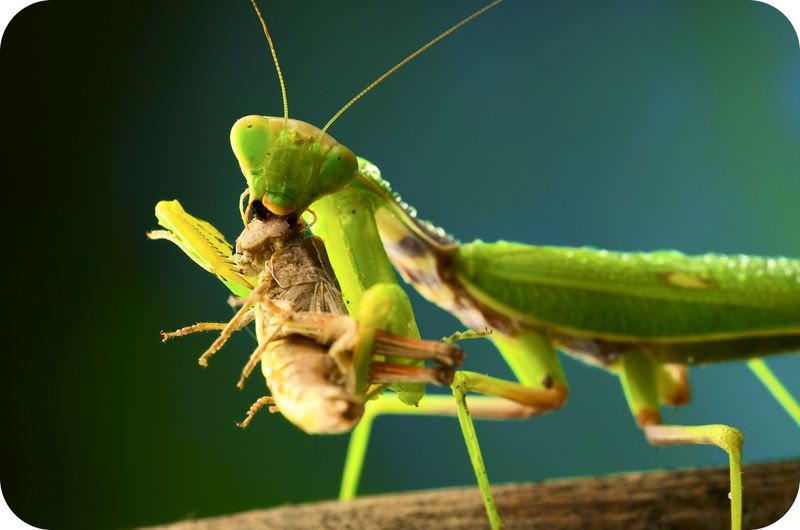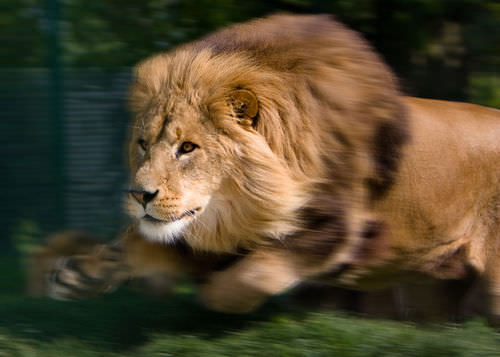12.8: Predation
- Page ID
- 14444

Can insects hunt for food?
When you think of an animal hunting for its food, large animals such as lions may come to mind. But many tiny animals also hunt for their food. For example, this praying mantis is eating a fly. To eat the fly, the praying mantis first had to catch the fly, which is a form of hunting.
Predation
Predation is another mechanism in which species interact with each other. Predation is when a predator organism feeds on another living organism or organisms, known as prey. The predator always lowers the prey’s fitness. It does this by keeping the prey from surviving, reproducing, or both. Predator-prey relationships are essential to maintaining the balance of organisms in an ecosystem. Examples of predator-prey relationships include the lion and zebra, the bear and fish, and the fox and rabbit.
There are different types of predation, including:
- true predation.
- grazing.
- parasitism.

True predation is when a predator kills and eats its prey. Some predators of this type, such as jaguars, kill large prey. They tear it apart and chew it before eating it. Others, like bottlenose dolphins or snakes, may eat their prey whole. In some cases, the prey dies in the mouth or the digestive system of the predator. Baleen whales, for example, eat millions of plankton at once. The prey is digested afterward. True predators may hunt actively for prey, or they may sit and wait for prey to get within striking distance. Certain traits enable organisms to be effective hunters. These include camouflage, speed, and heightened senses. These traits also enable certain prey to avoid predators.
In grazing, the predator eats part of the prey but does not usually kill it. You may have seen cows grazing on grass. The grass they eat grows back, so there is no real effect on the population. In the ocean, kelp (a type of seaweed) can regrow after being eaten by fish.
Predators play an important role in an ecosystem. For example, if they did not exist, then a single species could become dominant over others. Grazers on a grassland keep grass from growing out of control. Predators can be keystone species. These are species that can have a large effect on the balance of organisms in an ecosystem. For example, if all of the wolves are removed from a population, then the population of deer or rabbits may increase. If there are too many deer, then they may decrease the amount of plants or grasses in the ecosystem. Decreased levels of producers may then have a detrimental effect on the whole ecosystem. In this example, the wolves would be a keystone species.
Prey also have adaptations for avoiding predators. Prey sometimes avoid detection by using camouflage (Figure below). Camouflage means that species have an appearance (color, shape, or pattern) that helps them blend into the background. Mimicry is a related adaptation in which a species uses appearance to copy or mimic another species. For example, a non-poisonous dart frog may evolve to look like a poisonous dart frog. Why do you think this is an adaptation for the non-poisonous dart frog? Mimicry can be used by both predators and prey (Figure below).
Parasitism is a type of symbiotic relationship and will be described in the Symbiosis concept.


Summary
- Predation happens when a predator organism feeds on another living organism or organisms, known as prey.
- Predators can be keystone species, a species that can have a large effect on the balance of organisms in an ecosystem.
Explore More
Use the resource below to answer the questions that follow.
- Best Disguised Predator Fish? at http://video.nationalgeographic.com/video/stonefish-predation (1:18)
- What allows the stone fish to sneak up on prey?
- What does the stone fish eat?
- Where does the stone fish hide?
Review
- What is predation?
- What's the difference between grazing and true predation?
- What sorts of adaptations do prey have for avoiding predators?
- Predators can be a keystone species. What does this mean?

